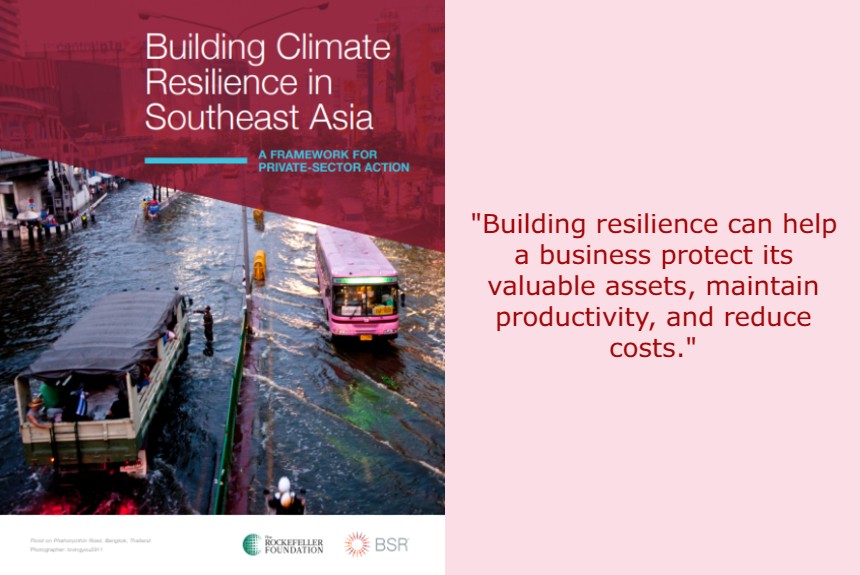Southeast Asia has a lot at stake from its current climate reality with a US $2.6 trillion market worth, home to more than 630 million people and many of the world’s supply chains.
An 18-month study that the Business for Social Responsibility (BSR) conducted, the “Building Climate Resilience in Southeast Asia,” examined the businesses in four Southeast Asian countries: Indonesia, Myanmar, Thailand, and Vietnam. BSR selected these countries because of their exposure and vulnerability to climate hazards.
The study looked into the following industries: manufacturing, including automobiles, garments, and information communications technology; tourism and hospitality; agriculture; and financial services.
Goals of the study
Because climate change affects the business core strategy and has cascading impacts throughout the operation process from the supply chains and the community it works with, it is worthy of action and leadership, the paper says.
The study seeks to analyse how the private sector in Southeast Asia is approaching climate risk and building resilience and then provide the businesses with tangible and accessible ways to understand climate risk and resilience and benefits from an improved adaptive capacity.
The scenario in Southeast Asia
Businesses in Southeast Asia are facing a myriad of climate change risks such as sea-level rise, extreme weather events, flooding, storm surges, temperature rise, drought, heatwaves, heavy rainfall, land degradation, biodiversity loss, and cyclones. The study states that these can have significant financial repercussions on their economy, human resources, and livelihood.
To avoid significant losses and for continuity of growth, businesses must prepare for these climate events and build resilience against them. The study says that resilience is the ability to anticipate, absorb, accommodate, and recover from climate change impacts.
It also recognises that climate action shall be a two-pronged approach: transition to a low-carbon economy and enhance adaptive capacity to climate hazards.
What the study found
Businesses lack long-term perspective and fail to account for climate impacts on their operations, supply chains, and the communities with which companies depend and work.
However, some businesses, like the auto industry, assess risk throughout their supply chains, incorporating climate hazards into their risk assessments.
For instance, they map suppliers to know whether they are in flood-prone areas. Then conduct surveys with suppliers to identify risks. Companies can find ways to protect their facilities from risks using the data from these surveys,
The study also presented other case studies that demonstrate companies’ climate actions to adapt and build resilience.
Taking action to build resilience
BSR’s September 2018 report says, “To maintain business continuity amid a changing climate, BSR recommends businesses take a three-dimensional approach to assess risk using the latest science compiled by the IPCC (Intergovernmental Panel on Climate Change):
- 1) Understanding the physical hazards of climate change,
- 2) Minimising exposure to these hazards, and
- 3) Reducing vulnerability or underlying weakness that can exacerbate risk.
After identifying the businesses’ hazards, exposures, and vulnerabilities, it should assess climate risks against the businesses’ capital assets, which are placed below.
After assessing climate risks, the business can strengthen one or more of the six capital assets to reduce risk and build resilience (Building Climate Resilience, 2018, September).
Six capital assets that need resilience
Figure 3 of the BSR report describes the six capital assets:
- Human capital refers to the skills and knowledge in the workforce
- Physical capital or the infrastructure, equipment, logistics, transport, and communication
- Political capital refers to the decision-making and policy-making processes
- Social capital or relationships, mutual support, and collaboration
- Financial capital refers to the financial resources and access to it
- Natural capital or biodiversity and ecosystems, including land and water.
These guidelines for assessing and identifying areas of climate risk resilience can be applied to the industries examined in the study, namely, the agricultural, manufacturing, tourism and hospitality, and financial services.
Why businesses should invest in climate resilience
“Building resilience can help a business protect its valuable assets, maintain productivity, and reduce costs. But the benefits of building resilience extend beyond business continuity and asset protection and link to the broader community and operating context” (Building Climate Resilience, 2018).
The paper offers helpful information, practical solutions and recommendations on how businesses in Asia can effectively tackle climate change.
Business owners, leaders, managers, and private sectors should take advantage of the information provided in this paper if they want to get a firm grip on climate change adaptation and mitigation.
Read the entire report by CLICKING on the image below:
Source:
Gallagher, Eileen. “Building Climate Resilience in Southeast Asia: A Framework for Private Sector Action.” BSR, June 2018. Retrieved from https://www.bsr.org/reports/BSR_Building_Climate_Resilience_in_Southeast_Asia.pdf




Leave a Reply